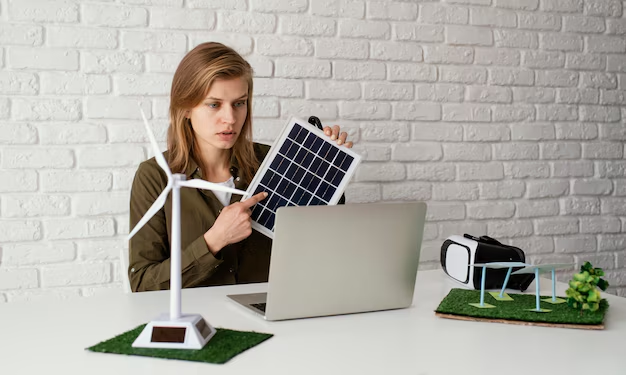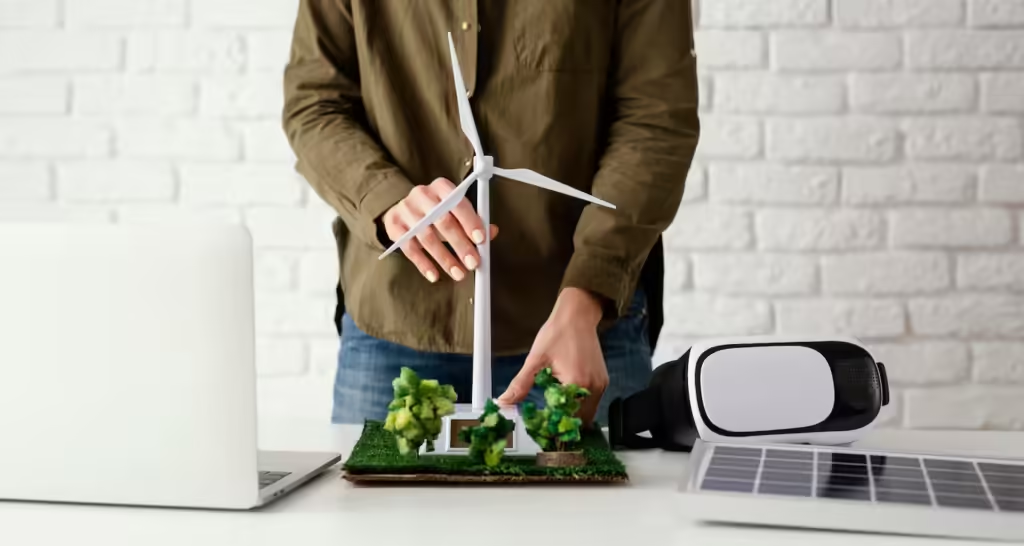Sustainability in Tech: Environmental-Friendly Gadgets
The discussion of climate change on this planet doesn’t seem to let up, with the rest of the industries beginning to look at the impact of their operations on the environment. The tech industry is no exception. Much has been achieved with the rapid growth of this technology sector, but for every step forward that comes a set of problems, especially on how resources are consumed, electronic wastes produced, and energy consumed. Recent pasts have made the tech firms encourage comprehensive greener tendencies as they come up with designs and productions of green gadgets that are less harmful to the environment.
There is a full move of environmentalism within the technological world-from recycled-plastic phones to eco-friendly smart home gadgets. But what is it, though, for a gadget to be “eco-friendly,” and why does that trend matter? This blog post will look at the emerging tide of sustainability in technology, glance through some interesting sustainable gadgets in the market, and then explore how tech companies-and, for that matter, consumers-can help reduce carbon footprints.
The Rise of Sustainable Technology:
This by itself-the manufacturing process, usage, and disposal of electronic equipment-actually impacts the environment directly. E-waste is a commonly referred term as electronic waste. E-waste forms one of the fast-growing streams of the world’s wastes. In 2019, the world generated 53.6 million metric tons of e-waste, of which most were dumped in landfills and thereby cause pollution and resource depletion. The carbon consumption used by data centers and electronic appliances in the world is also great.
Some of the most salient challenges to sustainability for the technology field are listed below:
- Resource Extraction: Most of the tech gadgets depend on a limited set of raw materials, that incorporate rare earth metals, lithium, and cobalt; these are used in batteries and electronic components. Mining is systematically destroying the environment and violating human rights in some areas.
- Energy Utilization: These appliances, especially if in case they are internet connected, use massive amounts of energy in their lifecycle: from the time when the product was manufactured to its use and residual life after use. Similarly, data centers are huge central points that store and manage vast amounts of information and use a very high amount of energy.
- E-Waste: Used electronics litter landfills, from where toxic material can find its way into the ground and air if not monitored. Recycling Levels for electronics also have miserly scores; unscientific disposal has been the prime cause of pollution and wastage of scarce material.
With this said, a demand is happening toward manufacturing devices that tend to be more eco-friendly than before. This kind of sustainable tech-solution is what consumers are looking for to use in the upcoming years as well.
So, What Makes A Gadget Eco-Friendly?

Basically, a green gadget is actually the product of principles of sustainability and is constructed generally so that it consumes less energy, produces less waste or uses recyclable or renewable materials. Some of the most characteristic features that can result in a more environmentally friendly gadget include the following:
1. Energy Efficiency
Consumption of Energy. One of the most important aspects of an eco-friendly gadget is the consumption of energy. Gadgets that utilize a small amount of energy in their working reduce the aggregate energy call for electricity; therefore, carbon emissions from power generation also decline.
Most recent gadgets, especially smart home appliances, are optimized with considerations to energy use. Examples include domestic appliances like energy-efficient LED lighting systems, smart thermostats, and many more sorts that can use the house hold energy at optimal ranges through the control of their working with the behavior of a user or environmental conditions.
Generally, one of the ways about knowing energy-saving products is through Energy Star certification. It means that it has passed the necessary standard criteria toward energy saving and therefore appropriate for the environmentally conscious consumer.
2. Recycled and Sustainable Materials
Many green gear is built from recycled material harvested from the environment in a sustainable way, including some communications companies have only in recent years started to use recycled plastics, metals and even glass in products which will eliminate the need for virgin materials and lighten the burden on those resources and that negative environmental impact.
Fairphone is one of those ‘hot brands’ which have committed to sustainability: high standards on the most ethically sourced smartphones and modularity-an ease of repairing rather than replacing devices. This minimizes e-waste and extends the life-span of the electronic product.
3. Modular design for repairability
The greatest contributors of e-waste occur mainly with the routine discarding of goods at their most straightforward or reduced moments in a normal process of disposal when it is easiest to repair.
For instance, though high-tech companies have faced various allegations about product designs that can never be repaired because they are too complex or perhaps spares are not available, more and more of these companies produce their products in modular form, a device which allows users to replace only the appropriate modules, such as the battery, screen, or memory module, thereby not requiring replacement of the whole gadget.
Framework Laptop: For example, this is a sustainable product with a chance for modularity design easy to upgrade or even repair parts such as a CPU, keyboard, etc. which do not contribute to extending its life cycle but help in minimizing the overall wastes formed due to the whole process.
4. Biodegradable and Compostable Material
Other companies which produce technology-based gadgets today are trying biodegradable materials to reduce electronic waste.
For instance, phone covers as well as some of these gadgets are now produced in biodegradable plastic or plant-based materials that break down much faster than other types of plastics that shall even take more than thousand years to completely break down.
Examples of the most relevant ones are technological accessories made from biodegradable products, known as bioplastics that are usually disposed of quite often since they are used in phone cases, chargers, and package wrappings.
5. Solar Gadgets

Solar devices are fueled by unlimited power from the sun, thus lowering their reliance on electricity produced from fossil fuels. They prove very convenient where electricity is quite a rare commodity or for users who wish to stretch their dependence away from the electric grid.
From small solar chargers that can charge any gadget on their own to huge portable solar panels used for powering an entire off-grid system, the technology is getting cheaper and efficient each year. For those consumers concerned with sustainability, these solar-powered tech devices can play the entire game as they offer an extremely friendly alternative to the old ways of charging.
Eco-Friendly Gadgets of 2024
These are some of the best green gadgetry in the circuit that have made waves within the tech community.
1. Fairphone 5
Fairphone is the first sustainable phone brand in the world. The company has added yet another new entry to its ethics-based line of consumer electronics: the Fairphone 5. Made of fair trade material, the company boasts that it is free from a defective chain with minerals that have conflict involvement. The company renders this product modularity, so users can readily replace components instead of throwing the whole phone into landfills.
2. Google Nest Thermostat
The Google Nest Thermostat is a smart appliance, which helps you to save power to the best of your ability. It learns your schedule, then through recognizing the activities, it pre-conditions your home and saves energy when you are away. The more it keeps you from unwanted heating/cooling expenses, the more this thermostset reduces your carbon footprint in the long term.
3. Apple iPhone 15 Pro
Apple has really made significant strides recently concerning sustainability. The iPhone 15 Pro is made from recycled materials, aluminum, rare earth elements, and tungsten. Apple will even make its supply chain carbon neutral by 2030, meaning that having the iPhone 15 Pro takes you one step closer to more sustainable technology.
4. Ecosia Browser
As not being a gadget in actual terms, Ecosia Browser is a technological instrument having positive impacts in the environment. Ecosia is the search engine that makes use of the profits earned from the searches towards planting trees globally. Every time you make searches using Ecosia, you are contributing to the restorations of the destroyed forest and climate change areas.
5. BioLite SolarHome 620
BioLite SolarHome 620 System-Based Solar Powered Technology Off-grid use. It is all a lighting, device charging, and radio powered by the sun. It is an off-grid solar powered technology designed for outdoor enthusiasts and small back communities found in remote areas with decreasing dependency on fossil fuel generation of electricity. Role played by tech companies in promotion of sustainability
The company continues to push ahead with the initiatives appealing to the consumer environmentally conscious.
Here are some of the ways in which the tech company is promoting sustainability:
1. Pursuit of Carbon Neutrality
The huge tech companies include Apple, Google, and Microsoft among others, who have tied themselves to some strident carbon neutrality targets. This will only mean that it will lead to fewer emissions of greenhouse gases, the use of renewable sources at the point of production, and offsetting whatever is left in environmental projects.
2. Extended product lifespan and software support
As part of the sustainability of gadgets, Elon Musk has always claimed that one part is by extension of product life. For a few years now, some firms have tried to stretch support software for their products so that users consume those products over many years without them having to upgrade their devices. In this respect, Google and Apple have provided several years of updates for smartphone software; hence, their useful lives.
3. Recycling Programs
At the heart of this problem stands the issue of recycling. As such, most companies now accept their products for recycling, through consumer return of old devices into these companies. For example, Apple’s Trade In enables customers to tender their old iPhones, iPads or Macs in return for some form of credit towards a new device, made effective under the promise that the old device would be disposed of responsibly.
How Consumers Can Help Sustainability in Tech

In fact, it is the consumers who can help much in sustainability by choosing the right purchase and usage. Here are a few steps you can undertake to minimize the negative impacts from being a consumer of technology:
- Choose energy-efficient products: Look for devices that are certified with Energy Star, the energy-saving label.
- Support sustainable brands with a great commitment to sustainability: Buy from companies committed to using source eco-friendly material sourcing; and also ethical sourcing while ensuring long term support for the software end.
- Extend the usage period of Gadgets: The more you maintain them the better. You fix them if they break, and you recycle them properly when they outlive their functionality.
- Buy recycled or refurbished gadgets : Buying old gadgets can cut market demand for virgin resource extraction and e-waste.
Conclusion
This generation of sustainability has long ceased to be a buzzword but is a must in gadget design, production, and consumption. Corporates are now working towards using such green materials and increasing energy efficiency, which will otherwise only be recycled back into becoming new consumer goods. In this way, it looks greener than ever for the future of technology. Still, consumers also play a crucial role in handpicking from these environment-friendly products that they have as part of their requirements. The adoption of such friendly gadgets and companies will surely make everyone a huge contributor to the betterment of the planet’s future.


